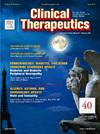抗肿瘤坏死因子治疗经验丰富的溃疡性结肠炎患者改用具有不同作用模式的生物制剂或循环使用另一种抗肿瘤坏死因子药物的治疗持久性
IF 3.2
4区 医学
Q2 PHARMACOLOGY & PHARMACY
引用次数: 0
摘要
目的:在溃疡性结肠炎(UC)中,抗肿瘤坏死因子(TNF)药物通常是一线生物治疗。如果最初的抗tnf失败,则必须切换到具有不同作用模式的生物制剂(ustekinumab和vedolizumab)或循环使用另一种抗tnf药物(阿达木单抗,英夫利昔单抗和golimumab)。该研究比较了UC患者在现实世界中的持续性,这些患者在抗肿瘤坏死因子无反应后转而使用具有不同作用模式的生物制剂或循环使用另一种抗肿瘤坏死因子。方法:从IQVIA PharMetrics®Plus数据库中选择2019年10月21日至2022年3月2日期间切换或循环(索引日期)的抗tnf治疗的UC成人。患者在第一次抗肿瘤坏死因子治疗前有≥12个月的连续保险资格,没有uc指示的生物制剂或高级治疗。在指标日期(基线期)之前的12个月内,患者没有其他免疫疾病,并停止了第一种抗tnf。使用治疗权重的逆概率来平衡基线特征。持续使用指数生物制剂的定义是在供应天数之间没有治疗暴露间隔> - 120天(ustekinumab, vedolizumab和英夫利昔单抗)或> - 60天(阿达木单抗和golimumab)。结果:转换队列包括488例患者(平均年龄:41.4岁;44.9%女性),周期队列包括129例患者(平均年龄40.7岁;43.8%的女性)。在维持期开始12个月后,持续患者的比例(切换队列:79.6%;周期队列:64.9%)和持续单药治疗的患者(切换队列:74.6%;周期组:48.0%)明显高于切换组和周期组;不使用皮质类固醇的持续患者比例在转换组(60.1%)也高于周期组(49.3%),但差异不显著。在转换队列中,持续率高出1.92倍(风险比[HR] = 1.92;95% CI, 1.31-2.82),单药治疗的持续率高出2.56倍(HR = 2.56;95% CI, 1.86-3.53),持续使用和不使用皮质类固醇的比率高出1.31倍(HR = 1.31;95% CI, 0.98-1.77)。意义:UC患者从抗肿瘤坏死因子药物切换到具有不同作用模式的生物制剂的治疗比循环使用另一种抗肿瘤坏死因子药物的患者更持久。研究结果可能有助于医生的病人经历治疗失败的第一个抗肿瘤坏死因子药物。本文章由计算机程序翻译,如有差异,请以英文原文为准。
Treatment Persistence Among Anti-Tumor Necrosis Factor–experienced Patients With Ulcerative Colitis Switching to a Biologic With a Different Mode of Action or Cycling to Another Anti–Tumor Necrosis Factor Agent
Purpose
In ulcerative colitis (UC), anti–tumor necrosis factor (TNF) agents often are first-line biologic therapy. Switching to a biologic with a different mode of action (ustekinumab and vedolizumab) or cycling to another anti–TNF agent (adalimumab, infliximab, and golimumab) is necessary if an initial anti–TNF fails. This study compared real-world persistence in patients with UC who switched to a biologic with a different mode of action or cycled with another anti–TNF after nonresponse to an anti–TNF.
Methods
Adults with UC treated with an anti–TNF, who switched or cycled (index date) between October 21, 2019, and March 02, 2022, were selected from the IQVIA PharMetrics® Plus database. Patients had ≥12 months of continuous insurance eligibility before the first anti–TNF without UC-indicated biologics or advanced therapies. During the 12 months before the index date (baseline period), patients had no other immune disorders and discontinued the first anti–TNF. Baseline characteristics were balanced using inverse probability of treatment weights. Persistence on the index biologic was defined as no therapy exposure gaps >120 days (ustekinumab, vedolizumab, and infliximab) or >60 days (adalimumab and golimumab) between days of supply. Composite end points were persistence while corticosteroid-free (<14 consecutive days of corticosteroid supply after day 90 post-index) and persistence while on monotherapy (no immunomodulators/nonindex biologics/advanced therapies). End points were assessed with weighted Kaplan-Meier and Cox proportional hazards models 12 months after the maintenance phase started.
Findings
The switch cohort included 488 patients (mean age: 41.4 years; 44.9% female), and the cycle cohort included 129 patients (mean age: 40.7 years; 43.8% female). At 12 months after the maintenance phase started, the proportions of persistent patients (switch cohort: 79.6%; cycle cohort: 64.9%) and persistent patients on monotherapy (switch cohort: 74.6%; cycle cohort: 48.0%) were significantly higher in the switch versus cycle cohort; the proportions of persistent patients while corticosteroid-free was also higher in the switch (60.1%) versus cycle cohort (49.3%) but was not significant. In the switch cohort, the rate of persistence was 1.92 times higher (hazard ratio [HR] = 1.92; 95% CI, 1.31−2.82), the rate of persistence while on monotherapy was 2.56 times higher (HR = 2.56; 95% CI, 1.86−3.53), and the rate of persistence and being corticosteroid-free was 1.31 times higher (HR = 1.31; 95% CI, 0.98−1.77) than in the cycle cohort.
Implications
Patients with UC who switched from an anti–TNF agent to a biologic with a different mode of action were more persistent on treatment than patients who cycled to another anti–TNF agent. Findings may aid physicians whose patients experience treatment failure on the first anti–TNF agent.
求助全文
通过发布文献求助,成功后即可免费获取论文全文。
去求助
来源期刊

Clinical therapeutics
医学-药学
CiteScore
6.00
自引率
3.10%
发文量
154
审稿时长
9 weeks
期刊介绍:
Clinical Therapeutics provides peer-reviewed, rapid publication of recent developments in drug and other therapies as well as in diagnostics, pharmacoeconomics, health policy, treatment outcomes, and innovations in drug and biologics research. In addition Clinical Therapeutics features updates on specific topics collated by expert Topic Editors. Clinical Therapeutics is read by a large international audience of scientists and clinicians in a variety of research, academic, and clinical practice settings. Articles are indexed by all major biomedical abstracting databases.
 求助内容:
求助内容: 应助结果提醒方式:
应助结果提醒方式:


